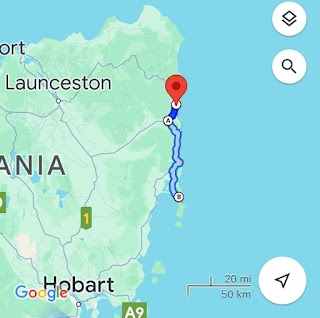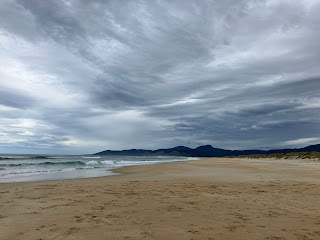 |
Austral storksbill, also known
as a Wild geranium! Indeed
it looked like a geranium to us.
This is native to Australia and New
Zealand. |
Feeling refreshed after a rest day, we headed south for one of the big tourist draws in this state, but you'll have to wait to tomorrow to see a photo of it.
We stopped on the way out of Scamander at the Winifred Curtis Scamander Reserve. Named after the late Dr Curtis, a Tasmanian botanist who had a lot of letters after her name, including Order of Australia. It was just bushland to us, but to someone in the field it must be a very special place. The brochure we got from the information centre says it's been largely untouched since European settlement. We did spot some little flowers that we realised later, when I looked them up, were natives.
Then we headed south via the inland route via St Marys, but carried on along a road called the Elephant Pass Road. This road was very windy, even more windy and narrow than many other Tasmanian roads and had no road markings on it. I'd hate to drive it at night! Amazingly it is designated as an "A" road—an "A" designation is apparently given to the state's most important arterial roads.
 |
| Blowhole at Bicheno |
While I am on roads, Tasmanian roads are something to be experienced. Whoever posted the speed limits was pretty unrealistic. Yes, we are driving a rather large box on wheels, but many times to feel safe, we're driving between 15 and 20 km/h lower than the posted limits! And it's not just that they are curvy, but that they are narrow, often without markings on the side, and the edges looks soft, so caution definitely seems necessary. It's a rare moment that we make it up to 100 km/hr and so we're allowing more time that we think we'll need to get anywhere. Also, we're making it a regular practise to pull off the road, where we can, if we get someone stuck behind us. Thankfully I haven't experience motion sickness here, though I have memories of feeling as such when our family came down here when I was 10, but of course I was sitting in the backseat then.
 |
| Rugged shoreline at Bicheno |
We made it to Bicheno for lunch at a bakery, then walked through some historical sites, and around the shoreline to see one of the local sites: a blowhole. Like many coastal towns in this region, sadly this used to be the base of whalers. We weren't stopping for the night here, so once again missed the penguins (they've been "sights to see" in other places we've been on the north coast too).
 |
| Large-flowered flat pea, native to Australia |
We did a tiny bit of grocery shopping then headed south to a caravan park in Coles Bay on the Freycinet Penninsula. We were in time to catch a sunset there and enjoy another quiet evening before tackling a hike the next day.
 |
| Common or Pink heath, also native |
 |
| Driving down the Freycinet Penninsula to Coles Bay |
 |
Sunset at Coles Bay
|








































